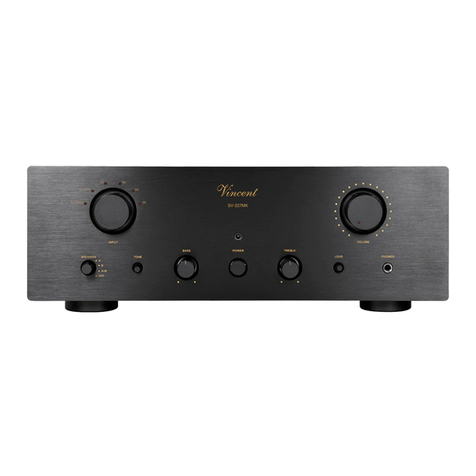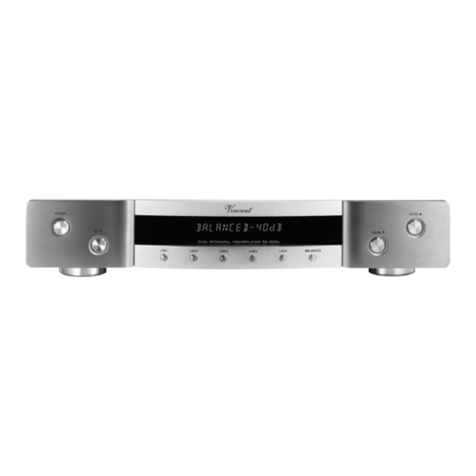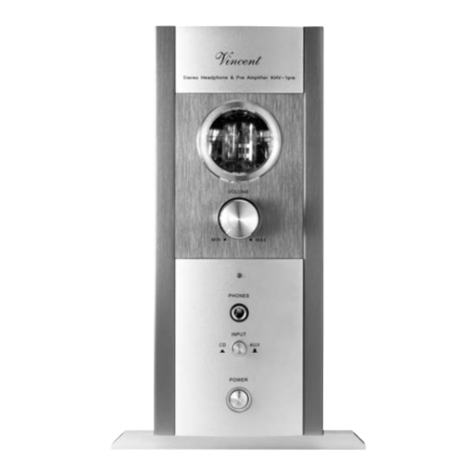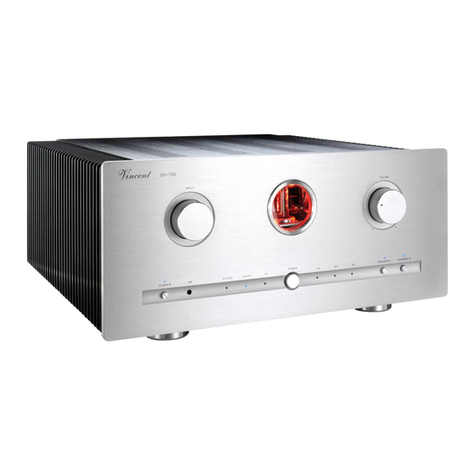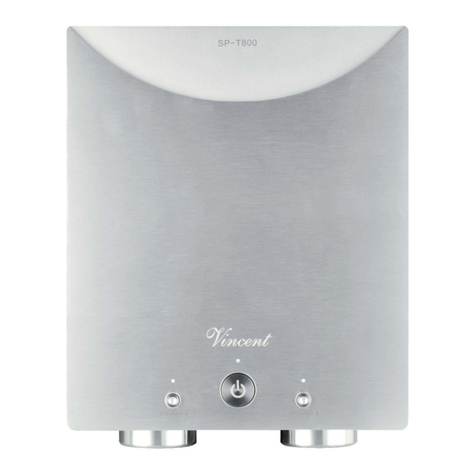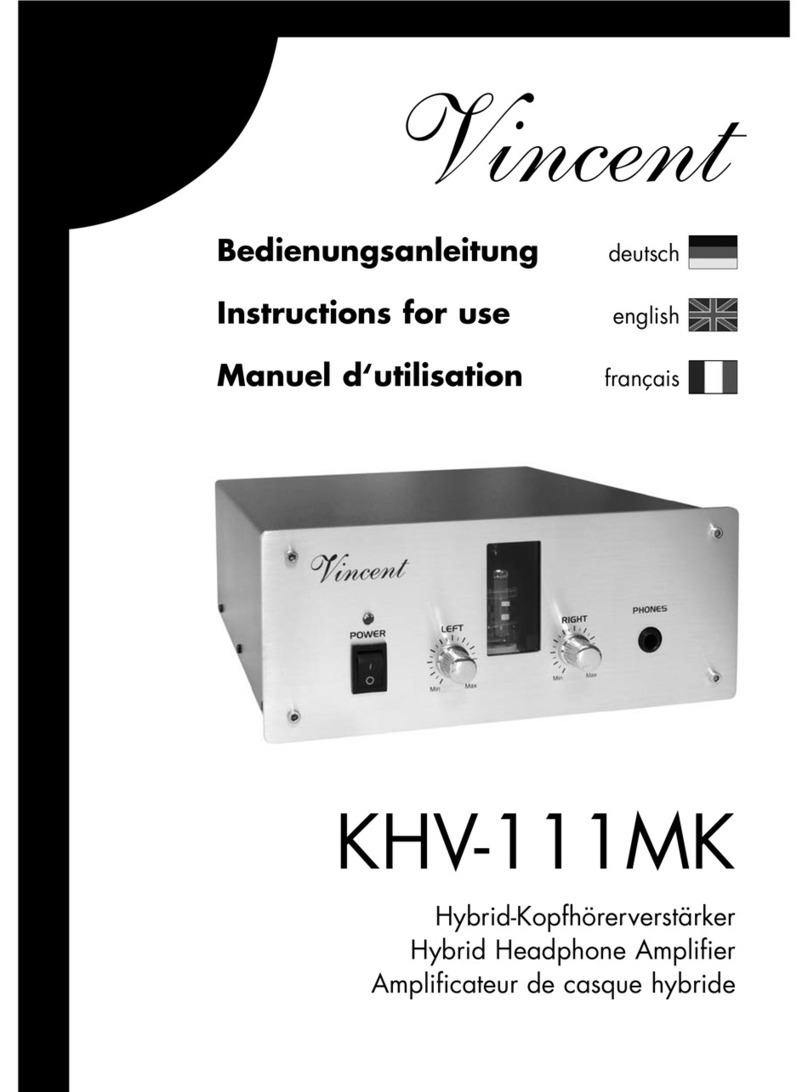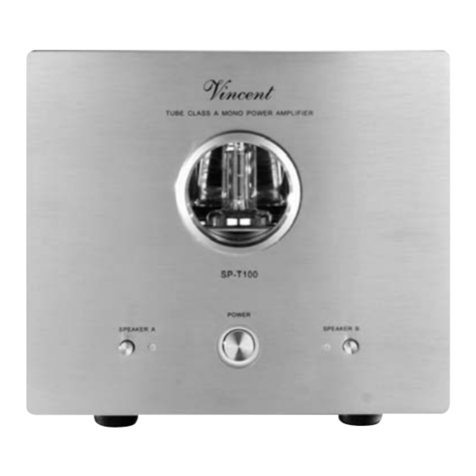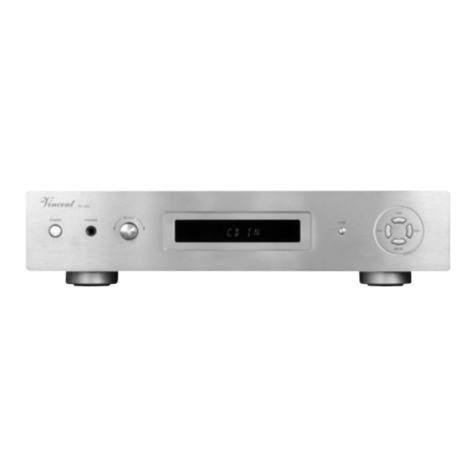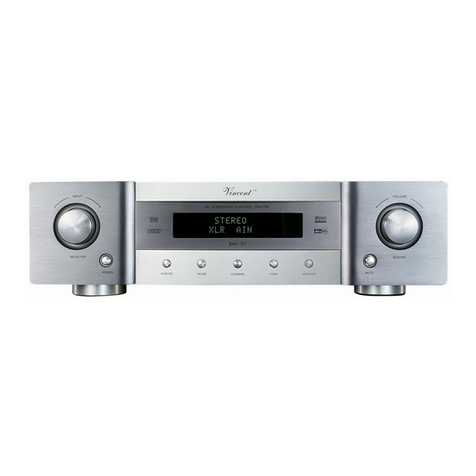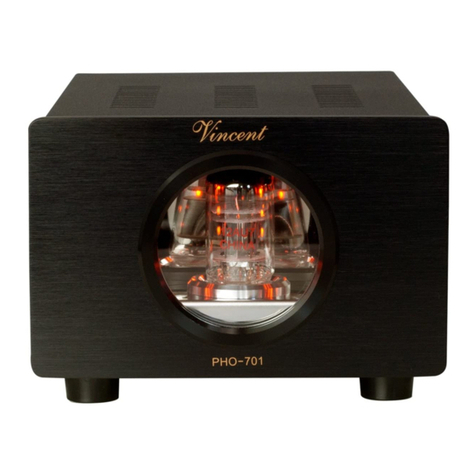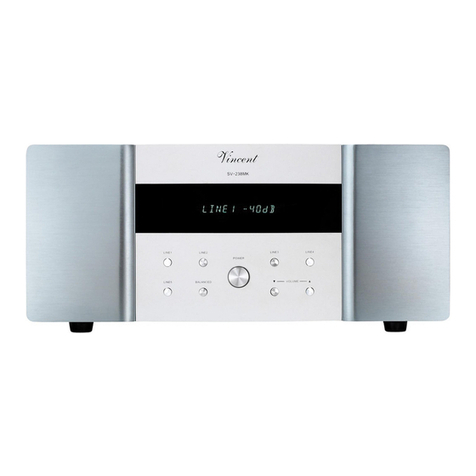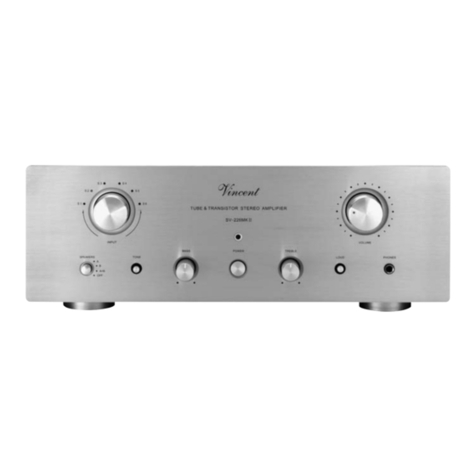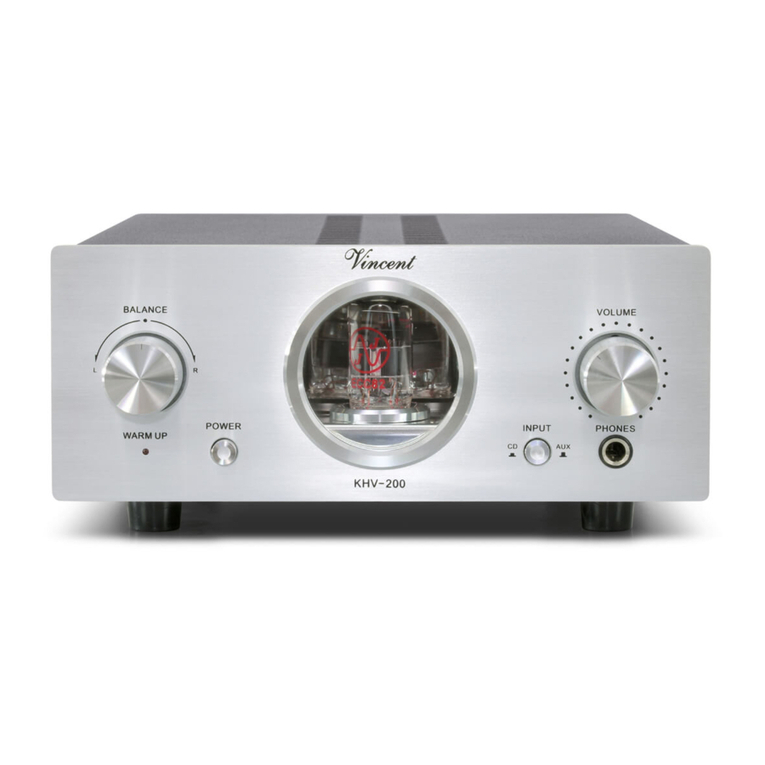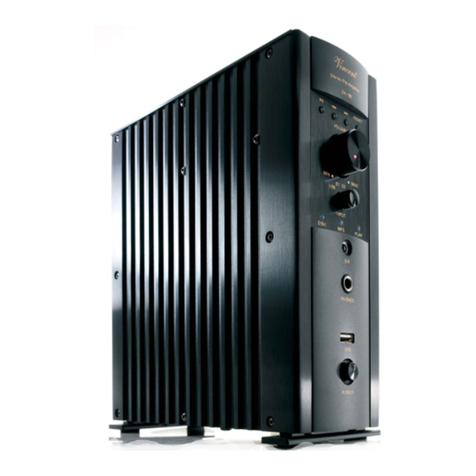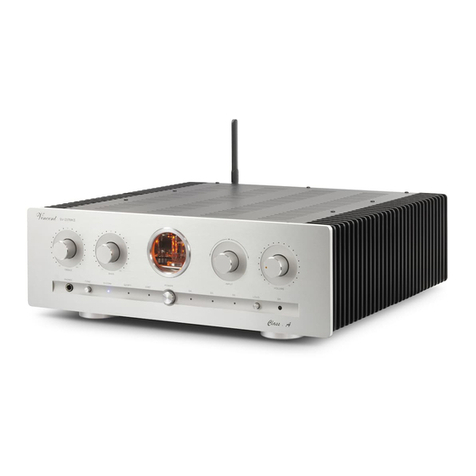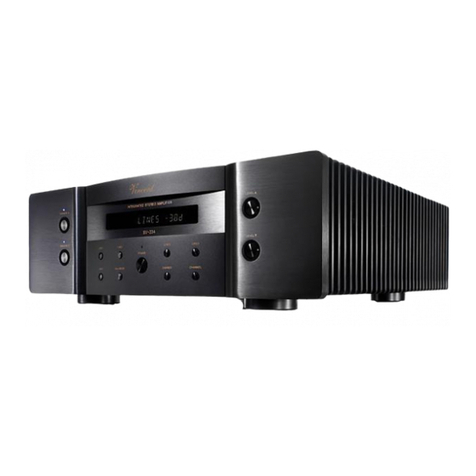Vincent
17
FEHLERSUCHE
Symptom Mögliche Fehlerursache Abhilfe
Keine Funktion nach
Drücken des Tasters
„POWER“
Netzkabel nicht an eine betriebsbereite
Steckdose angeschlossen.
Netzkabel nicht fest in die Steckdose und die
Gerätebuchse (8) gesteckt oder defekt.
An einem Anschluss für die „POWER CON-
TROL“ an der Geräterückseite ist ein Kabel
eingesteckt. In diesem Fall ist der Taster
„POWER“ (2) ohne Funktion.
Gerätesicherung oder Gerät ist defekt.
Stellen Sie eine Verbindung zu einer funktio-
nierenden Steckdose mit der geeigneten
Netzspannung her.
Prüfen Sie das Netzkabel, tauschen Sie es
gegebenenfalls gegen ein geeignetes Kaltge-
rätekabel aus und drücken Sie dessen Stecker
fest in die Steckdose und auf der anderen
Seite in die Netzbuchse des Gerätes.
Entfernen Sie das „POWER CONTROL“-
Kabel oder schalten Sie das Gerät ein, wel-
ches das Einschaltsignal ausgibt.
Kontaktieren Sie Ihren Fachhändler.
Kein Ton, obwohl
Gerät eingeschaltet
und aktiv (LED (3)
leuchtet)
Das momentan am Vorverstärker eingestellte
Quellgerät gibt kein Signal aus.
Ausgang des Quellgerätes nicht oder falsch
bzw. nicht mit dem gewünschten Eingangs-
anschluss des Vorverstärkers verbunden.
Falscher Eingangskanal am Vorverstärker gewählt.
Lautstärke am Vorverstärker zu niedrig eingestellt.
Der Vorverstärker ist stummgeschaltet (Mute-
Funktion).
Ausgang des Vorverstärkers nicht bzw. falsch
mit dem Eingangsanschluss (6) des SP-995
verbunden.
Die Einstellung des Eingangsumschalters „XLR
IN“ (4) an der Gerätevorderseite wurde
falsch getroffen.
Die Lautsprecherkabel sind nicht richtig mit
den Anschlussklemmen des SP-995 (5) ver-
bunden oder defekt.
Starten Sie die Wiedergabe der angeschlos-
senen Signalquelle.
Korrigieren Sie den Anschluss der
Signalquelle.
Korrigieren Sie die Eingangswahl.
Erhöhen Sie vorsichtig die Lautstärke.
Deaktivieren Sie die Stummschaltung (Taste
„MUTE“ des Vorverstärkers).
Korrigieren Sie den Anschluss des
Vorverstärkers.
Stellen Sie an diesem Umschalter den richti-
gen Eingangsanschluss ein.
Prüfen und befestigen Sie die Lautsprecher-
kabel an den Klemmen des Verstärkers und
an den Lautsprecheranschlüssen.
Schlechte Tonqualität
Anschlüsse der Kabelverbindungen sind lose, die
Anschlüsse verschmutzt oder ein Kabel defekt.
Ein Plattenspieler wurde ohne zwischenge-
schaltete Entzerrervorstufe (Phonovorstufe) an
einen der Hochpegeleingänge des
Vorverstärkers angeschlossen.
Ein Gerät mit Hochpegelausgang (z.B. CD-
Player) wurde an den Endstufeneingang
„LINE IN“ (6) angeschlossen.
Prüfen Sie die Audio-Anschlüsse.
Schließen Sie eine Phonovorstufe zwischen
Plattenspieler und Vorverstärker an.
Verwenden Sie Quellgeräte mit Hochpegel-
ausgängen nur an den Eingängen des
Vorverstärkers.
Tiefton- Brummen
zu hören
Siehe Abschnitt „Netzbrummen“ im Kapitel
„Weitere Tipps“.
Siehe Abschnitt „Netzbrummen“ im Kapitel
„Weitere Tipps“.
16
Vincent
Einspielzeit / Aufwärmen
Ihre Audio-Geräte benötigen eine gewisse Zeit bis
sie ihre klangliche Höchstleistung erreichen. Die-
ser Zeitraum ist für die verschiedenen Komponen-
ten Ihres Systems sehr unterschiedlich. Bessere und
gleichförmigere Leistung erhalten Sie während der
Zeit, die das Gerät eingeschaltet bleibt.
Nutzen Sie die Erfahrung Ihres Fachhändlers!
Netzbrummen
Bestimmte Quellgeräte können im Verbund mit dem
Verstärker zu einem über die Lautsprecher hörbaren
Brummgeräusch führen, dessen Lautstärke sich mit
dem Lautstärkeregler beeinflussen lässt. Dies ist kein
Hinweis auf einen Mangel eines Ihrer Audio-Pro-
dukte, muss aber durch entsprechende Maßnahmen
verhindert werden. Generell kann jedes an den Ver-
stärker angeschlossene, ebenfalls netzbetriebene
und mit dem Schutzleiter des Stromnetzes verbunde-
ne Gerät dieses Problem hervorrufen.
Dieses Phänomen wird erfahrungsgemäß entweder
durch den Antennenanschluss des Tuners bzw. Fern-
sehers oder in Verbindung mit Personalcomputern,
elektrostatischen Lautsprechern, Subwoofern, Platten-
spielern oder Kopfhörerverstärkern hervorgerufen,
sofern eine Audioverbindung zum Verstärker besteht.
WEITERE TIPPS
Eine weitere mögliche Quelle für Brummstörungen
stellt die elektromagnetische Einstrahlung des
Netzteiles anderer Geräte (z.B. Verstärker, Receiver,
CD-Player, Tuner usw.) auf das Tonabnehmersystem
eines angeschlossenen Plattenspielers dar. Solche
Fehlerursachen kann man leicht selbst ermitteln, in-
dem man die Aufstellung des Plattenspielers gegen-
über den anderen Geräten verändert.
Das Massepotential aller Signale ist in fast jedem
elektrischen Gerät an einem zentralen Punkt zusam-
mengefasst. Dort finden sie genau einmal eine
gemeinsame Verbindung. Sollte ein Schutzleiter vor-
handen sein, hat er immer an einer strategisch gün-
stigen Stelle eine unlösbare Verbindung mit dem
Gehäuse und beide werden meist auch genau ein-
mal am zentralen Massepunkt mit angeschlossen.
So wird auch die abschirmende Wirkung des Ge-
häuses erzeugt. Manche Geräte besitzen einen
Masse-Trennschalter (GND SWITCH) an der Ge-
räterückseite. Wenn dieser eingeschaltet ist (sich in
der Position „ON“ befindet), sind Schutzleiter und
Gehäuse gemeinsam vom Massepunkt abkoppelt.
Dies kann helfen, das Netzbrummen zu beseitigen.
Die Schutzleiterwirkung bleibt erhalten.
Ist das Brummgeräusch durch eigene Versuche nicht zu
beseitigen, wird Ihnen Ihr Fachhändler weiterhelfen.
